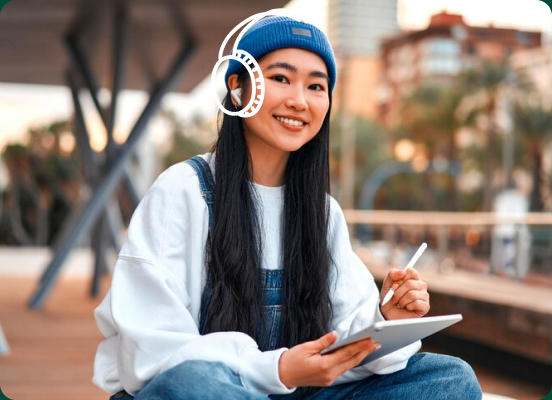Once upon a time, Etsy SEO (Search Engine Optimization) was easy: all you had to do was fill your Etsy tags and titles with the keywords that you wanted to rank for and voilà, you would appear on page one of an Etsy search.

But as more sellers swarmed the platform, Etsy was forced to evolve. These days, you have to do a bit more research: research that takes time; research that takes energy; research that can leave you feeling overwhelmingly confused if you don’t know what you’re doing.
I’m here to help! As a former preschool teacher, helping Etsy sellers learn in a way that is as fun and as easy as preschool is a hallmark of my brand as an Etsy coach. On that note, if you’re a total newbie at SEO, you might want to start with this quickie blog post, Etsy SEO for Beginners, in which I break down the most essential basics: what SEO is, and an intro to keyword research.

In this post, I’m going to be talking about some of the top factors that contribute to your search ranking on Etsy – that is, on which page and where on that page will your listing appear in a typical Etsy shopper’s search result. For example, if someone typed into Etsy’s search bar: “Valentine’s Day gifts for women,” you would want your listing as close to page one as possible, right? Or in the top rows of page three or four – not all the way back on page 404.
Unfortunately, gone are the days when we could just search Etsy ourselves to see where on what page our listings would display in a shopper’s search. Back in the day, if I wanted to know what my listing’s search ranking was on Etsy, I would just type in one of the keywords that I used in my listing title, and simple as that, could see on which Etsy search result page it turned up. Today though, Etsy’s algorithm – their own top-secret formula that Etsy uses to organize and retrieve listings – has changed dramatically, and now there are quite a few factors that play into what page your listings will land on. Here are the top seven.
Factor Number One: Relevancy
If someone is searching for baby shower gifts on Etsy, the last thing they want to find is men’s underwear and antique cigar boxes. This is where relevancy comes in. Basically, relevancy is a gauge of how closely your listing tags, titles, attributes, and product details match a search query that someone types into Etsy’s search bar. The more relevant the terms that you use are, the more likely it is that your listing place higher in search. (To learn more about Keyword Research, at the end I’ll provide links to some excellent articles and other resources for you.)

Factor Number Two: Listing Quality Score
This is a secret, undisclosed score or rating that Etsy gives to each listing. The Listing Quality Score is based on how users interact with that listing once they click on it. For example, if you list what appears in your thumbnail to be a big bag of marbles, and someone shopping for a big bag of marbles clicks on that listing only to find that you’re actually selling only one marble, they might feel misled and quickly click off that listing without making a purchase. Your Listing Quality Score would likely be negatively affected. The shopper clicked on then quickly clicked back off the page: this signals Etsy that what you’re selling wasn’t what they searched for, and furthermore, that it might not be interesting to other buyers, either.
Conversely, let’s say that your listing is for a beautiful bridal bouquet, and that you have an eye-catching thumbnail of your bridal bouquet, along with lots of photos, a detailed product description, competitive price point, and generous shop policies. Someone searching Etsy for a bridal bouquet who clicked on your thumbnail might end up spending time exploring your listing, favoriting that item, eventually even making a purchase – all of which would positively influence your listing’s quality score, and tell Etsy that other shoppers for bridal bouquets might be interested in this item, as well.

Factor Number Three: Recency
This Etsy behavior is easy to miss, yet super important to grasp so that you understand what’s happening, and can anticipate, plan for, and make the most of it. When presented with a brand-new listing, it’s impossible for Etsy to give it a Quality Score, right? You just listed the item; it’s unlikely that anyone has had time to click on it, let alone interact with it. So instead, Etsy will give your new listing a brief boost in search. This allows Etsy to quickly gather the data it needs on how shoppers interact with it. After a bit of time (it might be a few hours or a few days) spent observing shopper interactions, Etsy begins to formulate a Listing Quality Score to determine your new listing’s placement (rank) in search. Etsy does the same for new shops. You may see a flurry of views, visits, hearts, even sales – then, it dies. You wonder why. Recency is why.

Factor Number Four: Customer and Market Experience Score
Sigh, yes another Etsy score that they tell us about, but they never actually show us. This score was instituted to make sure that shops with a five-star reputation get ranked higher in search. Totally understandable: Etsy wants to make sure they’re not promoting to the top any shops with a history of terrible customer service or consistently-awful reviews. And this is exactly why things like great reviews, completing your Shop Policies, and filling out your About section are so important. These positively impact your Customer and Market Experience Score, and thus your search ranking, because these demonstrate to Etsy that you’re a trustworthy shop. One-star reviews, cases filed against your shop, and copyright infringement claims hurt your overall search ranking.
Factor Number Five: Your Shipping Price
Please don’t look at me with those thumbs down! That would be shooting the messenger. I am not in support of this practice. I am simply reporting Etsy’s stance. In March of 2018, Etsy surveyed shoppers and those shoppers said they were 50% less likely to make a purchase if they thought the shipping price was too high. In July 2019, Etsy announced their decision to give products with free shipping an extra boost in search.
But definitely do not lose your noodle. Of course we all know that there’s no such thing as “free shipping:” someone pays, whether it’s the customer or you. If you can afford to build the cost of shipping into the price of your item, go ahead and experiment with it to see if it makes a worthwhile difference. If you can’t, don’t sweat it! Just make sure that you’re not inflating that shipping cost in order to make an extra buck. That is what turns away customers.

Factor Number Six: Language and Translations
Whatever language you selected when you set up your Etsy account is the language you should be using for your listing tags and titles. Although Etsy translates these for you into other languages if you sell internationally, even Etsy admits that their translator technology is far from infallible. So if you are fluent in other languages and you’d like to cater to those shoppers, any translations you do manually will override Etsy’s. (Etsy has said themselves that these tags tend to be higher quality and may outperform their machine translations.)
Factor Number Seven: Shopper Habits
Here’s the big one, the one that changed everything several years ago – a change that created mass pandemonium! Along with the factors that we’ve covered so far, the ultimate factor in ranking on Etsy is this: Etsy tailors each search result specifically for each shopper.
Etsy isn’t alone. You know how whenever you search for a brand on Google, right afterwards you magically start seeing ads for that specific brand everywhere? That’s no coincidence: it’s called machine learning, and it’s how advertisers target shoppers based on interests evidenced by search history and other online activity.

It’s also why if I were to type “Valentine’s Day gifts for women” into Etsy search, and you were to type “Valentine’s Day gifts for women” into Etsy search, the things that I see might be completely different from the things that you see. Etsy refers to this as its Context Specific Ranking (CSR) technology. It’s more broadly known as personalized search. Drawn from an ever-evolving, continuously-updated machine-learning analysis of our respective search histories, Etsy shows me things they think I personally would like, while the things they’re showing you are based on the things that they think you personally would like.
Now, with these seven factors in mind, you may be wondering, how the heck do I know which of my listings are performing well and which are not? There are two methods.
Method one: head over to your Etsy stats and look at the listings in your shop that are bringing in the most traffic compared with the ones that aren’t. If you notice that some of your listings aren’t generating much traffic, it may be time to work on your SEO for those under-performing listings.
Method two: use eRank’s handy-dandy Rank Checker tool to see what page your listing would land on for a shopper with no search history on Etsy. (Rank Checker is able to strip out Etsy’s individualized search personalization, along with paid ads.) Then, if you see in Rank Checker’s results that some of your listings display on page one, it means that your SEO is probably pretty good.

For any of your listings that show up way back, or not at all – Rank Checker will display any of your items it finds in the top 500 listings for a given search term – you may want to start working on your SEO for those specific listings.
This lesson is just one of many in an Etsy SEO series that I’m currently working on. SEO is a challenge for most Etsy sellers, but with enough time, enough practice, and enough research, any seller can master it.
Other resources:
Learn more about the 7 factors that affect your rank via Etsy’s Seller Handbook.
Keyword Research: To read a detailed, how-to demo about using eRank’s Keyword Tool to do Keyword Research, Pam Duthie wrote a great post, Putting eRank’s Keyword Lists to Work: A Demo.
There are other helpful blog posts on eRank here. To ask questions or talk about how to use eRank, check out eRank’s Facebook community.
For a video version of this blog post on my YouTube channel, click here.








